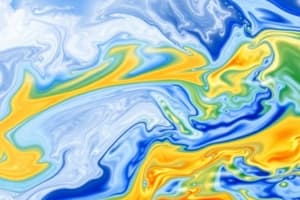Podcast
Questions and Answers
How does cloud cover affect temperatures during the day?
How does cloud cover affect temperatures during the day?
- Cloudy skies lead to higher ground temperatures than clear skies.
- Cloudy conditions have no impact on ground temperatures during the day.
- Cloud cover absorbs more heat than clear skies.
- Cloudy skies reflect solar radiation, resulting in lower ground temperatures. (correct)
What happens to temperatures at night when the sky is cloudy?
What happens to temperatures at night when the sky is cloudy?
- Temperatures remain constant due to sunlight.
- Temperatures are usually lower due to heat escaping.
- Clouds increase the rate at which heat escapes into space.
- Clouds slow the escape of heat, resulting in higher temperatures. (correct)
During cloudless weather, what effect does the absence of clouds have on daytime ground temperatures?
During cloudless weather, what effect does the absence of clouds have on daytime ground temperatures?
- Ground temperatures are higher because more heat is absorbed. (correct)
- Ground temperatures fluctuate more than during cloudy conditions.
- Ground temperatures are unaffected regardless of cloud presence.
- Ground temperatures are generally lower due to more humidity.
Which process involves water changing from a liquid state to a gaseous state?
Which process involves water changing from a liquid state to a gaseous state?
What is the term for water that falls from clouds to the ground?
What is the term for water that falls from clouds to the ground?
Flashcards are hidden until you start studying
Study Notes
Cloudy Weather
- Cloudy weather has lower diurnal temperature range than cloudless weather due to the effect of clouds on incoming and outgoing radiation.
- During the day, clouds reflect some solar radiation back into space, reducing the amount of heat absorbed by the ground. This leads to lower ground temperatures compared to cloudless days.
- At night, clouds act as a blanket, slowing down the rate of heat escaping into space. This results in higher nighttime temperatures compared to clear nights.
Cloudless Weather
- In the absence of clouds, more solar radiation reaches the ground during the day, leading to higher ground temperatures compared to cloudy days.
- At night, with no clouds to trap heat, more heat escapes into space, resulting in lower nighttime temperatures compared to cloudy nights.
Hydrological Cycle
- Precipitation is the water that falls from clouds to the ground.
- Groundwater refers to the slow movement of water beneath the Earth's surface.
- Surface runoff is the water that flows over the surface to reach bodies of water like streams.
- Evaporation is the process where liquid water transforms into a gaseous state.
- Transpiration is the process of water loss through the surface of plants.
- Condensation is the process where water vapor changes from gaseous to liquid state.
Studying That Suits You
Use AI to generate personalized quizzes and flashcards to suit your learning preferences.




